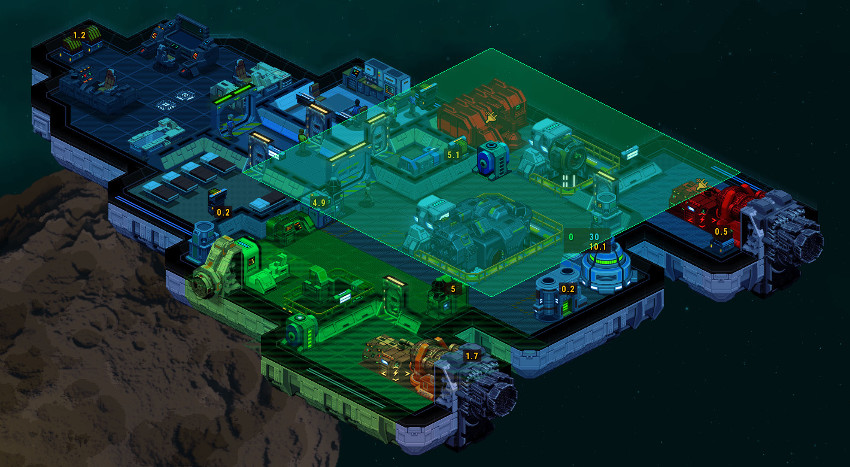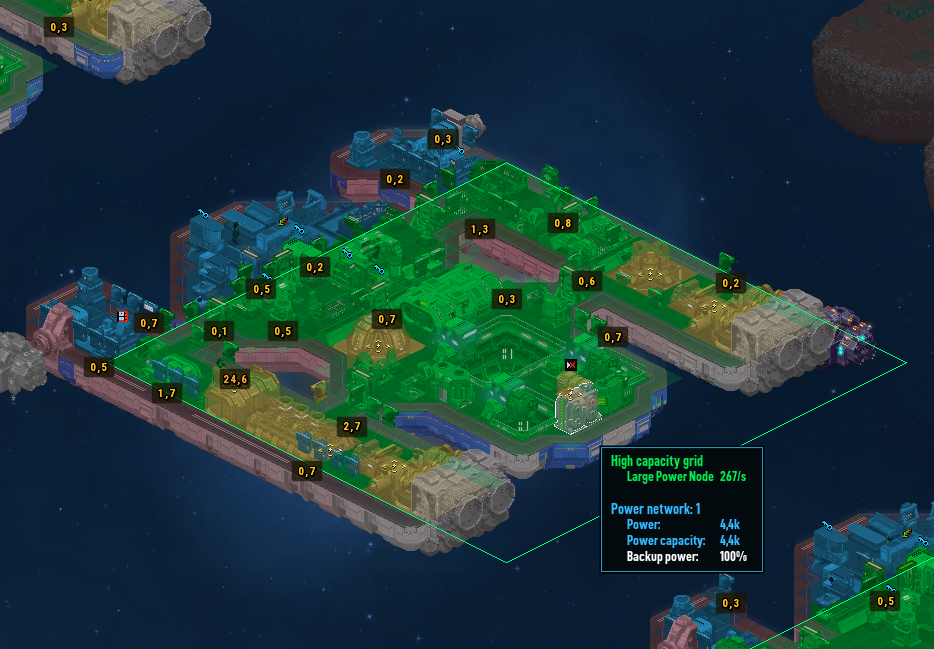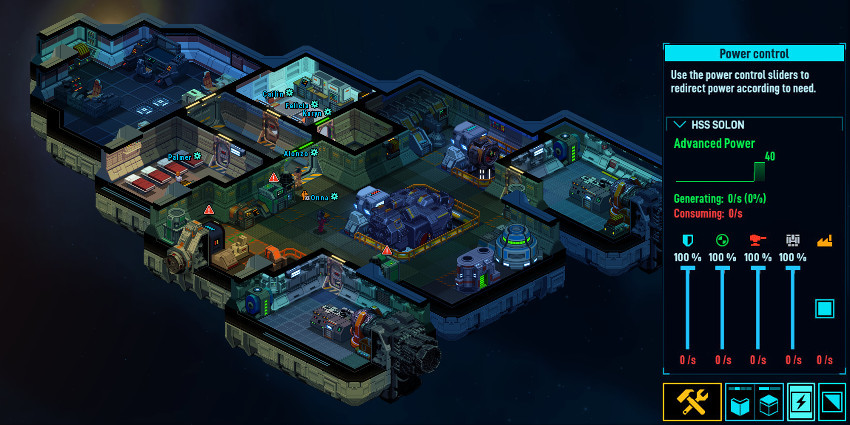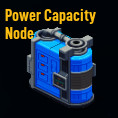Difference between revisions of "The Power Grid"
Jump to navigation
Jump to search
m |
|||
| (36 intermediate revisions by 2 users not shown) | |||
| Line 1: | Line 1: | ||
| + | ==The Power Grid== | ||
| − | + | [[File:Power grid 850x467.jpg]] | |
| − | |||
| − | == | + | ==Low Capacity Power and High Capacity Power== |
| − | |||
| − | + | The power grid is divided into two networks, the low capacity grid and the high capacity grid. | |
| − | |||
| − | + | * Low Capacity Power - has distribution integrated into the hull and is capable of powering facilities with low power needs. As such, the distribution of Low Capacity Power is automatic and covers the whole ship. | |
| + | * High Capacity Power - Is power transmitted from a node, needed for facilities with a higher power demand. These are all industry facilities and facilities related to ship-to-ship battles (Turrets and Shields). | ||
| − | + | '''The power grid consists of:''' | |
| − | |||
| − | The power grid consists of | ||
| − | |||
| − | |||
* Power Generators - These are the power generator facilities and others like the solar panel. | * Power Generators - These are the power generator facilities and others like the solar panel. | ||
| − | * Power distribution modules - These are the power nodes, distributing power within areas | + | * Power distribution modules - These are the power nodes, distributing high capacity power within areas. |
| − | * Power storing modules - This | + | * Power storing modules - This are the power capacity node, capable of storing a substantial amount of high capacity power and the backup power node storing backup power. |
| − | * Power consumers - All the facilities requiring power to operate, with power consuming spikes depending on their functionality. | + | * Power consumers - All the facilities requiring power to operate, with power consuming spikes depending on their functionality. Most facilities only need Low capacity power distribution integrated into the hull, while industry and ship-to-ship battle related facilities require high capacity power transmitted from a node |
| − | |||
| − | |||
| − | |||
| − | |||
| − | |||
| − | |||
| − | |||
| − | |||
| − | |||
==Power Nodes== | ==Power Nodes== | ||
| − | + | Power nodes are capable of distributing power in a wireless way within a certain area, providing all facilities with power within that area. | |
| + | The area needs to cover the yellow energy square of the facility. | ||
| − | + | [[File:Large_Power_Node_in_Energy_View.png]] | |
'''Power nodes come in different shape and forms:''' | '''Power nodes come in different shape and forms:''' | ||
| − | * The Power Node - This is the sturdiest of the power nodes, with the widest power distribution area | + | * The Large Power Node - This is the sturdiest of the power nodes, with the widest power distribution area. However, it also takes up valuable space. |
| − | * The | + | * The Small Power Node - This is the medium range power node. Takes less space than the large power node. |
| − | |||
| − | |||
| − | |||
==Step-by-Step to set up the power grid== | ==Step-by-Step to set up the power grid== | ||
| − | |||
| − | |||
# Build a power generator / Ensure you have a power generator built. | # Build a power generator / Ensure you have a power generator built. | ||
| − | # | + | # Facilities with a low power need will automatically receive power through the ship hull itself. |
| − | # | + | # Facilities with a high power need, such as industry facilities and ship-to-ship battle related facilities, will need High Capacity Power. |
| − | # | + | # Expand the advanced power grid with a power node. |
| − | + | ## Rinse and repeat to expand the advanced power grid even further according to need! | |
| − | # | ||
| − | |||
| − | |||
| − | |||
| − | # Rinse and repeat to expand the power grid even further! | ||
| − | == | + | ==The Power Control Menu== |
| + | [[File:Power control menu 02 850x425.jpg]] | ||
| − | + | The power control menu controls how advanced power is distributed to various ship systems, including shields, operations (Scanner), turrets, hyperdrives and industry. The power control menu can be accessed from the lower right part of the user interface. | |
| − | + | ===Boosting Power=== | |
| − | + | [[File:Power capacity node.jpg]] | |
| − | |||
| − | |||
| − | It is | + | * It is possible to achieve settings above 100% in the power control menu. This can be done by building power capacity nodes, each giving a 5% increase to the maximum power available for a system. |
| + | * Boosting will decrease recharge times for the systems, meaning turrets and shields will recharge faster. Boosting is capped to a 20 percentage point increase, by building 4 power capacity nodes. | ||
| + | * Additional power capacity nodes (Over 4 units) will not increase the maximum beyond 120% for a system. | ||
| + | ** '''Over 100%''' Means the facilities within a system category are boosted. Boosting will make the facilities perform faster but parts of the facilities will degrade over time as long as the facility is boosted. | ||
| + | ** '''100%''' Means that the facilities within this system category are allowed to receive their full maximum need of power. | ||
| + | ** '''50%''' Means that the facilities within this system category are allowed to receive only half of their maximum need. This will affect their behavior, make them operate slower. | ||
==Troubleshooting== | ==Troubleshooting== | ||
| − | * If the power grid | + | * If the power grid starts flickering/running out of power in some areas it means the generator is not capable of creating enough supply for the demand. This can be improved by building another power generator. One power generator will only be capable of sustaining a certain amount of power need. |
| − | * | + | * If some facility is not receiving high capacity power even though they are covered by a power node, check that the settings in the power control menu are set to allow enough power to a system. |
[[Category:Gameplay]] | [[Category:Gameplay]] | ||
Latest revision as of 16:57, 8 September 2025
Contents
The Power Grid
Low Capacity Power and High Capacity Power
The power grid is divided into two networks, the low capacity grid and the high capacity grid.
- Low Capacity Power - has distribution integrated into the hull and is capable of powering facilities with low power needs. As such, the distribution of Low Capacity Power is automatic and covers the whole ship.
- High Capacity Power - Is power transmitted from a node, needed for facilities with a higher power demand. These are all industry facilities and facilities related to ship-to-ship battles (Turrets and Shields).
The power grid consists of:
- Power Generators - These are the power generator facilities and others like the solar panel.
- Power distribution modules - These are the power nodes, distributing high capacity power within areas.
- Power storing modules - This are the power capacity node, capable of storing a substantial amount of high capacity power and the backup power node storing backup power.
- Power consumers - All the facilities requiring power to operate, with power consuming spikes depending on their functionality. Most facilities only need Low capacity power distribution integrated into the hull, while industry and ship-to-ship battle related facilities require high capacity power transmitted from a node
Power Nodes
Power nodes are capable of distributing power in a wireless way within a certain area, providing all facilities with power within that area. The area needs to cover the yellow energy square of the facility.
Power nodes come in different shape and forms:
- The Large Power Node - This is the sturdiest of the power nodes, with the widest power distribution area. However, it also takes up valuable space.
- The Small Power Node - This is the medium range power node. Takes less space than the large power node.
Step-by-Step to set up the power grid
- Build a power generator / Ensure you have a power generator built.
- Facilities with a low power need will automatically receive power through the ship hull itself.
- Facilities with a high power need, such as industry facilities and ship-to-ship battle related facilities, will need High Capacity Power.
- Expand the advanced power grid with a power node.
- Rinse and repeat to expand the advanced power grid even further according to need!
The Power Control Menu
The power control menu controls how advanced power is distributed to various ship systems, including shields, operations (Scanner), turrets, hyperdrives and industry. The power control menu can be accessed from the lower right part of the user interface.
Boosting Power
- It is possible to achieve settings above 100% in the power control menu. This can be done by building power capacity nodes, each giving a 5% increase to the maximum power available for a system.
- Boosting will decrease recharge times for the systems, meaning turrets and shields will recharge faster. Boosting is capped to a 20 percentage point increase, by building 4 power capacity nodes.
- Additional power capacity nodes (Over 4 units) will not increase the maximum beyond 120% for a system.
- Over 100% Means the facilities within a system category are boosted. Boosting will make the facilities perform faster but parts of the facilities will degrade over time as long as the facility is boosted.
- 100% Means that the facilities within this system category are allowed to receive their full maximum need of power.
- 50% Means that the facilities within this system category are allowed to receive only half of their maximum need. This will affect their behavior, make them operate slower.
Troubleshooting
- If the power grid starts flickering/running out of power in some areas it means the generator is not capable of creating enough supply for the demand. This can be improved by building another power generator. One power generator will only be capable of sustaining a certain amount of power need.
- If some facility is not receiving high capacity power even though they are covered by a power node, check that the settings in the power control menu are set to allow enough power to a system.



